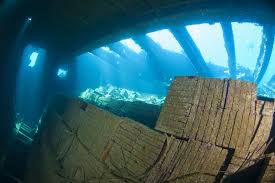The Abu Nuhas reef in the Red Sea is a little piece of heaven for wreck divers. Also known as the “wreck eater,” or the “scrap yard” because of the many ships that have struck the reef and sunk here over the years, the reef really lives up to its name. One of these wrecks is the Chrisoula K or, as it’s also known, the Tile Wreck, due to a cargo of Italian tiles onboard when it went down, which can still be seen in and around the wreck.
Of all the wrecks that found their final resting place on Abu Nuhas (four diveable wrecks, but more are in the depths nearby), the Chrisoula K sparks the most debate. Identifying wrecks can be a tricky business in the best of circumstances, but it’s all the more difficult with this particular wreck. In the absence of an identifiable name on the hull or elsewhere, divers are left to estimate a ship’s identity based on size, age, construction, cargo and whatever else they can make out from the remains of a ship. The problem with this wreck is that not just one, but two, cargo ships of more or less the same size and age sank here, the Chrisoula K and the Marcus, and to complicate matters even further, they were both — improbably — carrying a cargo of Italian tile. The Marcus went down a few years earlier than the Chrisoula K, and there was one unlucky sailor who — again, improbably — was aboard both ships when they wrecked.
Without any markers to confirm the ship’s final identity, the debate has been raging for years about which of the two wrecks it is. More recent attempts at identification have indicated that the two wrecks may in fact be sitting on top of each other, with pieces of both mixed together, adding to the confusion. For my part, I’m staying out of the debate, and choosing to follow Shakespeare’s lead by saying that “a wreck of any other name makes just as beautiful a dive.” And the Tile Wreck is certainly that.
Continue reading this article from Scuba Diver Life







Leave A Comment